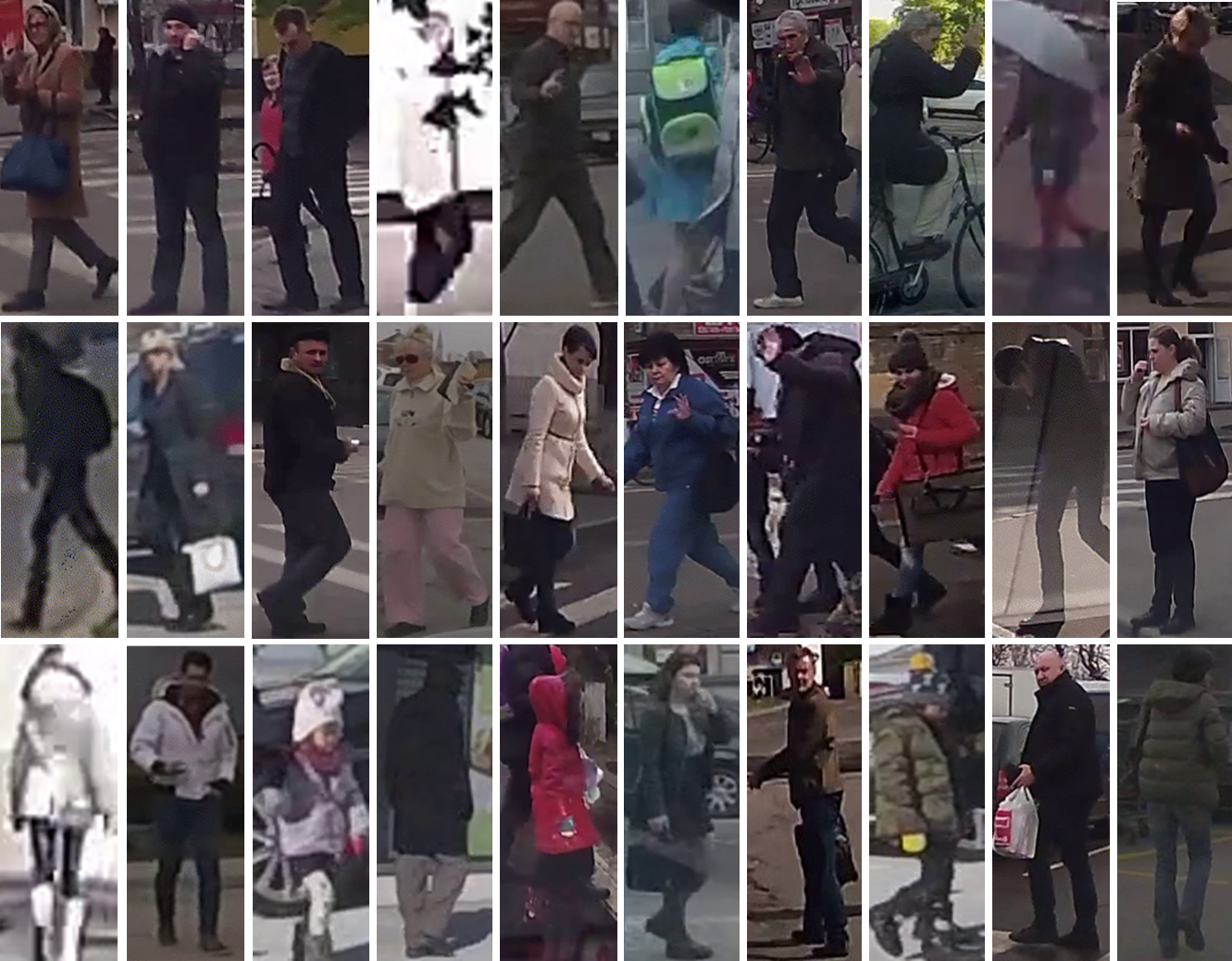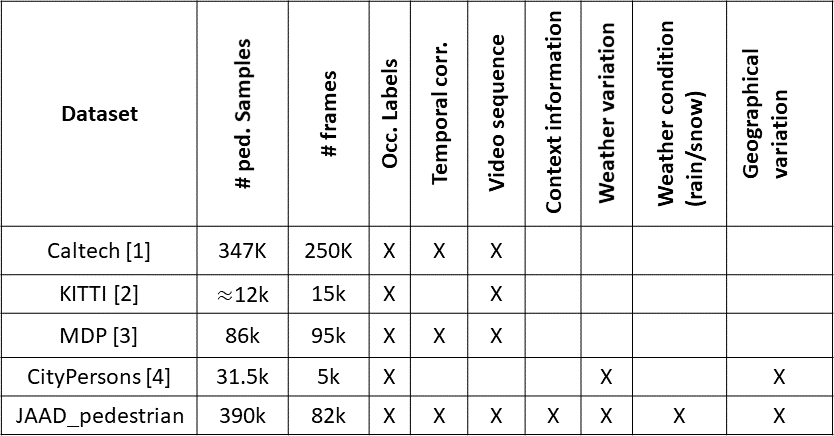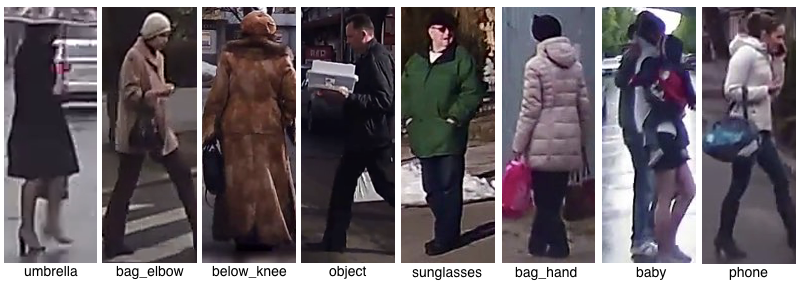JAAD Pedestrian Detection Benchmark is an extension of the JAAD dataset annotated for detection of pedestrians under various conditions. The annotations are avaiable for the entire JAAD dataset comprising over 390K pedestrian samples in traffic scenes. A comparison of JAAD dataset with current state-of-the-art pedestrian detection benchmark datasets can be found in the table below.
The image samples can be downloaded from the JAAD webpage. The data comes as video sequences in both .mp4, and .seq format similar to the Caltech dataset.
JAAD contains 346 high-resolution video clips generating approximately 82k image samples. The JAAD data is collected in different geographical locations and under various weather conditions such as clear, rainy or snowy.
To convert the video clips to image sequences, use the script 'split_clips_to_frames.sh'.
The bounding boxes are provided for all pedestrians in the videos (and very few vehicles) in vbb format which require a Piotr Dollar's Toolbox. All pedestrian samples in every image are annotated with a unique id allowing one to track each sample across video sequences.
There are two folders with bounding boxes.
- vbb_part: contains bounding boxes with occlusion flags set to 1 for partial or full occlusion (partial occlusion is defined when between 25% and 75% of the object is covered, full occlusion is set when >75% of the object is covered).
- vbb_full: contains bounding boxes ONLY with full occlusion.
To open vbb files in Matlab use the following command from the toolbox:
A = vbb('vbbLoad', 'vbb_part/video_0001.vbb');
There are three types of labels in the vbb files:
- car, car1, car2, ... - vehicles (only few vehicles that interact directly with the driver are labeled)
- pedestrian, pedestrian1, pedestrian2, ... - pedestrians with behavioral tags
- ped1, ped2, .... - other pedestrians visible in the scene (bystanders) without behavioral tags and attributes
To view vbb boxes with .seq files use the vbbLabeler utility provided with the toolbox.
For experimentation with the dataset and use different subsets of the dataset please use our Pedestrian Benchmark Framework (PBF).
A number of appearance attributes are provided for each pedestrian in the dataset including coarse pose, clothing color and length, presence and location of the bag/backpack, headwear, accessories, etc.
Mat files with annotations for each video in the JAAD dataset can be found in pedestrian_appearance_attributes folder. Each mat file contains a struct array ped_attr with number of elements equal to the number of frames in the video. For each frame we define a cell array pedestrians with pedestrian labels and cell array attributes with 1x24 binary vector corresponding to the attributes in attribute_names cell array. For frames with no pedestrians both fields are empty arrays.
Below is Matlab console output showing how to access the attributes stored in the .mat files:
>load('pedestrian_appearance_attributes/video_0001.mat');
>ped_attr(10) %attributes for frame 10
>ans =
pedestrians: {'ped1' 'ped2' 'ped3' 'pedestrian'} %cell with pedestrian labels
attributes: {1x4 cell} %pedestrian attributes in the same order as the labels
>ped_attr(10).attributes
>ans =
[1x24 double] [1x24 double] [1x24 double] [1x24 double] %binary arrays with appearance attributes
The following 24 attributes are defined in the attribute_names cell array: pose_front, pose_back, pose_left, pose_right, clothes_below_knee, clothes_upper_light, clothes_upper_dark, clothes_lower_light, clothes_lower_dark, backpack, bag_hand, bag_arm, bag_shoulder, bag_left_side, bag_right_side, cap, hood, sunglasses, umbrella, phone, baby, object, stroller/cart, bicycle/motorcycle.
- pose_front, pose_back... - coarse pose of the pedestrian relative to the camera
- clothes_below_knee - long clothing
- clothes_upper_light, clothes_lower_dark... - coarse clothing color above/below waist
- backpack - presence of a backpack (worn on the back, not held in hand)
- bag_hand, bag_elbow, bag_shoulder - whether bag(s) are held in a hand, on a bent elbow or worn on a shoulder
- bag_left_side, bag_right_side - whether bag(s) appear on the left/right side of the pedestrian body
- cap,hood - headwear
- umbrella,phone,baby,object - various things carried by the pedestrians
- stroller/cart - objects being pushed by the pedestrian
- bicycle/motorcycle - for pedestrians riding or walking these vehicles
If you use our dataset in your research, please consider citing:
@inproceedings{rasouli2017they,
title={Are They Going to Cross? A Benchmark Dataset and Baseline for Pedestrian Crosswalk Behavior},
author={Rasouli, Amir and Kotseruba, Iuliia and Tsotsos, John K},
booktitle={Proceedings of the IEEE Conference on Computer Vision and Pattern Recognition},
pages={206--213},
year={2017}
}
@inproceedings{rasouli2018role,
title={It’s Not All About Size: On the Role of Data Properties in Pedestrian Detection},
author={Rasouli, Amir and Kotseruba, Iuliia and Tsotsos, John K},
booktitle={ECCVW},
year={2018}
}
- Amir Rasouli
- Yulia Kotseruba
Please send email to yulia_k@cse.yorku.ca or aras@cse.yorku.ca if there are any problems with downloading or using the data.
This project is licensed under the MIT License - see the LICENSE file for details
[1] P. Dollar, C. Wojek, B. Schiele, and P. Perona. Pedestrian detection: A benchmark. In CVPR, pages 304–311, 2009
[2] A. Geiger, P. Lenz, C. Stiller, and R. Urtasun. Vision meets robotics: The kitti dataset. The International Journal of Robotics Research, 32(11):1231–1237, 2013.
[3] S. Hwang, J. Park, N. Kim, Y. Choi, and I. So Kweon. Multispectral pedestrian detection: Benchmark dataset and baseline. In CVPR, pages 1037–1045, 2015.
[4] S. Zhang, R. Benenson, and B. Schiele. Citypersons: A diverse dataset for pedestrian detection. In CVPR, pages 4457-4465, 2017.


